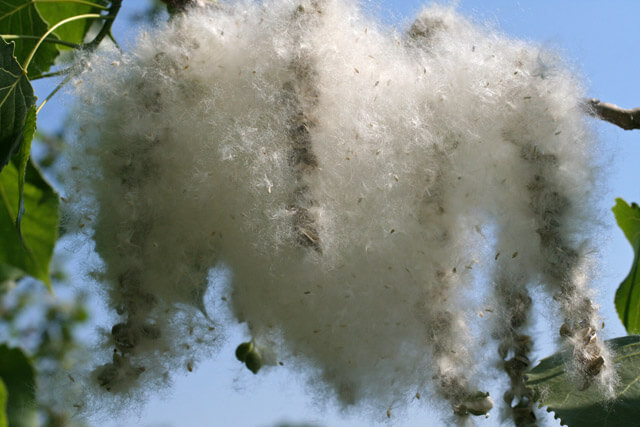 My neighbor is kind of strange and I thought that he might have blown up a mattress in his backyard last week. There were all these cotton fluff-balls floating and lying all around the neighborhood. Then I visited a friend in another town and she has that fluff all over, too. What are these soft cotton-like globs from?
My neighbor is kind of strange and I thought that he might have blown up a mattress in his backyard last week. There were all these cotton fluff-balls floating and lying all around the neighborhood. Then I visited a friend in another town and she has that fluff all over, too. What are these soft cotton-like globs from?
You have found the calling card of a tree that takes its name from this material: the cottonwood. This is the Eastern cottonwood; the botanical name is Populus deltoides. They belong to the poplar family with other poplars like quaking aspen and Lombardy poplar.
The trees are very fast growing. They can grow rapidly to 50 to 75 feet tall. But this also means that they have soft wood and short lives. The leaves are shiny and roughly triangular. By the time the tree gets to be 70 years old, if it makes that far, it declines rapidly.
They are prone to many canker and leaf diseases. They would not be the tree to plant next to your house or park under in a windstorm.
In the spring, the tree flowers with pendulous catkins even before the leaves appear. The catkins have a thin stem and round buds that dangle on each side of the catkin stem. After the tiny flowers bloom, the seeds are produced. The cottony material causes the small whitish seeds to float on the wind for long distances.
A large tree can produce a great deal of fluffy stuff. If you pick up some of the cottony material, you can find seeds attached, sort of like dandelions. Cottonwood seed tufts are notorious for getting stuck to window screens and air conditioning units.
Check yours to make sure that the cotton is not causing the Air Conditioning to struggle because of lack of circulating air. Usually the fluff is dispersed in June. Because of the early warm season, people were finding cotton in May. When thinking of cottonwoods, just consider them messy with dropping twigs, branches and seed fluff and junky because of easy breakage and disease problems.
I found something really odd on one of my maples. There were patches of what looked like red felt on the top of a few leaves. It’s really red and feels sort of fuzzy or like plush or flocking. Now, I have found it on a couple of leaves on a hawthorn tree. It’s spreading and I know that this is going to do some damage. What is this stuff and how to I save my trees?
Good news; they’re already saved. What you have found is not serious or even mildly annoying to the trees, just the owners. Just classify this problem of almost microscopic gall mites as cosmetic; it looks bad.
The tiny, red mass of galls are there and that’s the end of the sentence. What you see is all that you or the tree leaves are going to get. They don’t kill leaves, affect the tree’s health or turn into something worse. You have found the handiwork of one variety of gall mite that is called eriophyid mites. They make those colorful erineum galls you have been staring at.
Various eriophyid mites live on different kinds of trees. Your felt patches can be found in red, white, brown and green.
There are eight different eriophyid gall mites found on silver maples alone. Erineum galls are very common on maples but other kinds can be found on alder, elm, beech, hickory, hawthorn, linden and mountain ash. They can be on the tops or the bottoms of leaves.
Early spring foliage is often affected, especially leaves close to the trunk and on the larger branches. The adults spend the winter tucked under the bark of the tree and happily skip to the new unfolding leaves. And you have found their Technicolor production.
